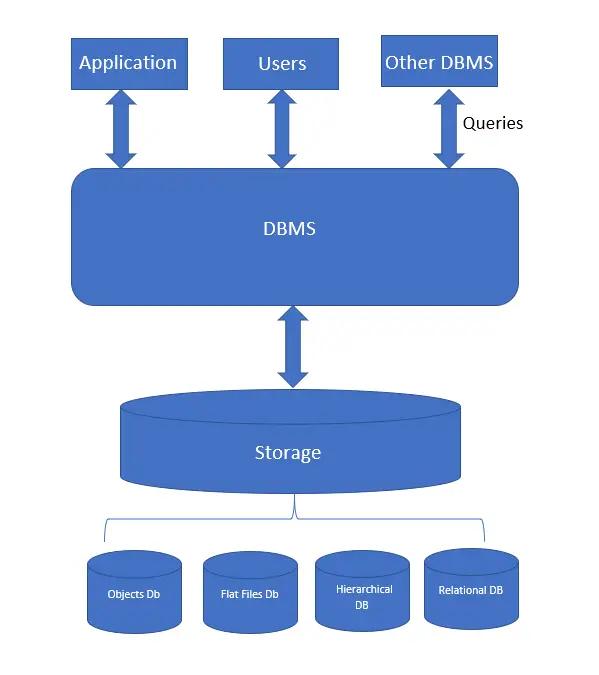What is DBMS?
DBMS stands for Database Management System which is a software used to manage databases. For Example, MySQL, Oracle, etc. are some of the popular commercial DBMS today, it primarily functions as an interface between users and the database at the same time managing the data in order to facilitate the organization and manipulation of data.
A general-purpose Database management system has features such as:
- It should be user-accessible
- Data abstraction
- Data independence
- Data security
- Concurrency and Transaction control
- Data recovery support
Overview of DBMS:
A basic DBMS structure looks like this where Users, Applications and other DBMS makes a query to the underlying DBMS software which in turn makes queries to the storage of the which can have many implementations such as
- Data can be stored as Objects
- Data can be stored in Flat Files
- Data can be stored in a hierarchical manner
- Data can be stored in the Relational Database
Database management system functions through the system commands receive instructions from the user, the instructions are then accordingly processed, either modifying or retrieving data from the database.
Different types of Data models in Database:
An abstract model that is used to organize elements of the data and the way a data is stored and retrieved, the standard way of how different data relate to each other. Different models are
- Relational data model: Data is organized in a logically independent table.
- Network data model: Entities are organized in a graphical representation.
- Hierarchical data model: Data is organized in a tree-like structure.
Difference between DBMS and a Traditional file system:
The traditional file system was used in the early days where a manual filing system or file-based structure where files are typically stored on a device such as Hard disk and CD-ROM facilitated easy-access of the data.
But the traditional file system had its drawbacks, as it was inexpensive and ideal for small scale operations but
DBMS is expensive but the traditional system of files is cheap.
DBMS is great for large systems and they are scalable but the traditional systems are used in small systems having small no of files and items to store.
DBMS is highly secured and is sharable.
Applications of DBMS
Airlines, Universities, Banking, Human Resources, eCommerce, selling, and anywhere where data is important.
Uses of DBMS
- Effective and efficient management of data.
- Query processing and management.
- Security and integrity of data.
- Data sharing and storage.
Advantages of DBMS
- Reduction of redundancy.
- Data integrity, security.
- Backup and recovery.
- The data model can be developed.
- Concurrency control.
- Data independence.
- The performance is good.
Disadvantages of DBMS
- It requires large size of memory.
- Time-consuming.
- Required a processor with the high speed of data processing.
- Cost of data conversion.
- Database failure (DB corrupted due to power failure or whole system stops).
- Expensive.
- Complex.
- Higher impact of failure (if any component can bring the operation to a halt).
- Cost of DBMS (depend on the environment, function or recurrent annual maintenance cost.
Features of DBMS
- Persistence.
- Validity.
- Consistency.
- Security.
- Non-redundancy.
- Independence.
- Concurrency.
Advantages of Traditional File System
- Less complex.
- Simple to use.
- Secured
- Minimal investment.
Disadvantages of Traditional File System
- Data redundancy.
- Data inconsistency.
- Data dependence.
- Limited data sharing.
- The problem with security.
- Retrieval.
- Inefficient to maintain a large number of records.
